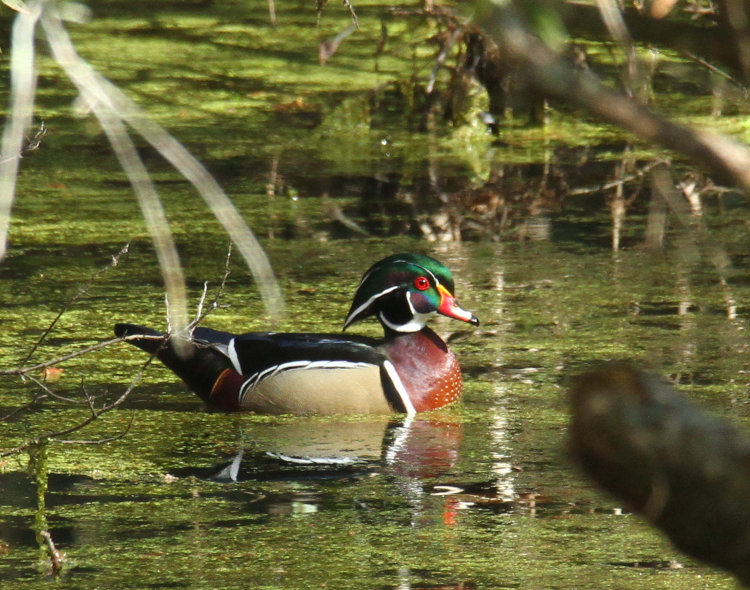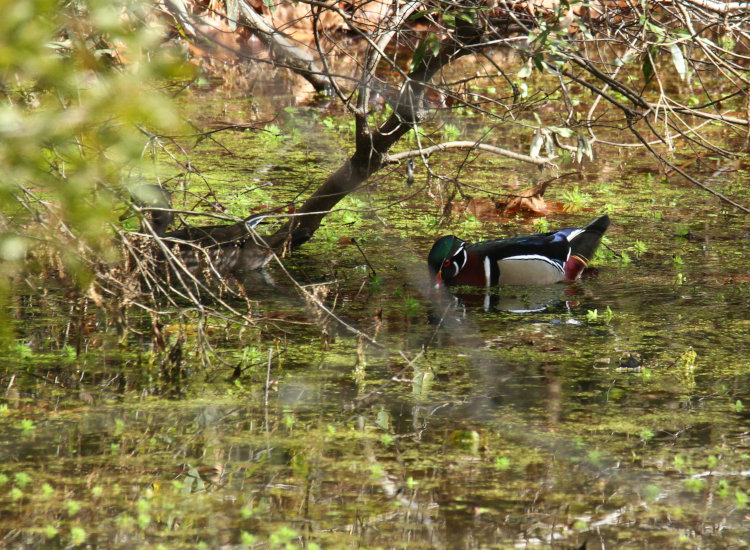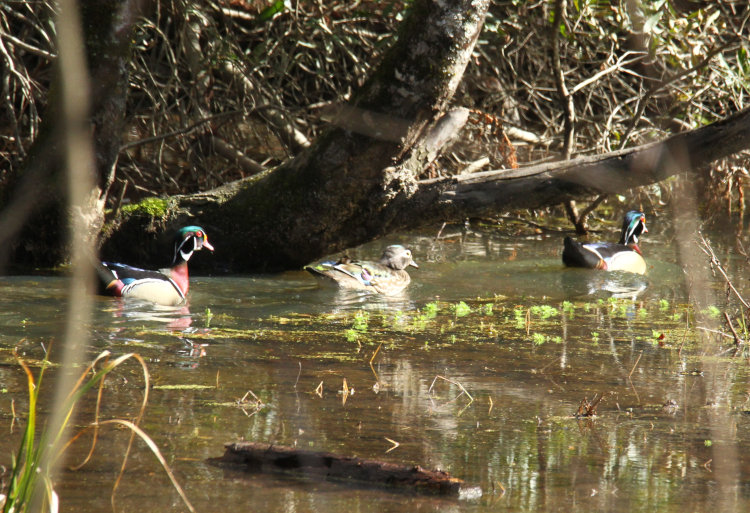Today is Darwin Day, and unlike last year, I actually have something for the day – just not much. Again, the reminders have been coming up in my calendar for the past week, and that hasn’t been enough to inspire something meaningful, but I do have a handful of observations that have provoked some speculation, if only because I’m not properly educated about the subject (or indeed, any.)
We’ve been keeping an eye on the visiting wood ducks (Aix sponsa,) which they’re doing their best to thwart – they’re secretive little waterfowl. And it’s all being done from a distance, usually through the back windows, because they won’t allow even moderately close approaches, and my presence up on the deck (50-70 meters distant) is usually enough to send them under cover, at least. But a few traits stand out regardless, and it makes me wonder about how they evolved.

First off, the males have remarkable coloration, as noted before, and it becomes even more appealing when they get into direct sunlight – but the females are distinctly drab (that’s a duck joke.) This holds true for many bird species, and the speculation is that the coloration of the males indicates their health and robustness, a message to the females that they’re good husband material. Songs also seem to fit this bill (just full of them, aren’t I?,) not only demonstrating healthy lungs, but their repertoire might indicate experience, a bird that has survived more travels than most. Yet the brilliant plumage, at least, comes at a cost, because it makes them exponentially more noticeable to predators as well, and this is especially so with birds that develop long and elaborate plumage during mating season, among them peacocks. The belief (because how could you possibly prove this?) is that the benefits of finding a mate and passing on their genes outweighs the hazards of making them more noticeable and perhaps hampering their flying agility.
Wood ducks have iridescent feathers, meaning the colors really stand out in bright sunlight, but they have a tendency not to appear in bright sunlight very often – from what I’ve seen, they try to cross open water rather quickly and spend a lot more time in shadow where the iridescence fails and the feathers appear black.

The females are a lot harder to notice, and yet, they also stay in shadowed overhangs a lot more than the males do; from initial observations, the males check out the surroundings first, with the females following many seconds later. What I think is happening here is that the males serve as the decoys (nonstop puns,) going first into potentially dangerous areas to see if they draw unwanted attention, with the females following only after nothing has happened for a little while – not long, but about five to fifteen seconds in my experience. It makes sense (but again, is hard to prove): without the females, no reproduction is going to take place, no matter how fit and wonderful the male might be. And males working to draw predators away from the females and/or young has been witnessed many, many times before. Even if they die while doing so, once they’re already mated, their genes are being passed on by protecting the females and young – and that’s what natural selection accomplishes. Keep the lineage going.

Most of the wood duck visitors to the main pond are pairs, and as they retreat towards areas that they feel safer within (for instance, when I’ve been rash enough to let them see me,) the males always lead the way, with the females following or sandwiched between flanking males like seen here. As far as I’ve been able to see, even when they fly off in alarm, it’s the male in the lead. It’s usually not hard to see such details, you only have to be paying attention.
Now, as for why the males have that overhanging, rebel-scum helmet on their heads? I’m not even going to try and explain that one. Sometimes such things are only for display, and it’s possible that it helps differentiate them from the mallards that they hang out with; it might also provide some advantage to their flight. I have seen how the white stripes actually break up their profile when they’re in overhanging branches, but the coloration of the females (the mallards too) is much more effective: it can be easy to spot the males, but it often requires the binoculars to determine that the females are around too, even when they’re in open water right alongside the males. One would think that it could perhaps be better for the males to attract as little attention as the females, yet there remains the whole “I’m a good choice” message that needs to get across too, and this is highly present throughout the avian kingdom. It must be working.



















































